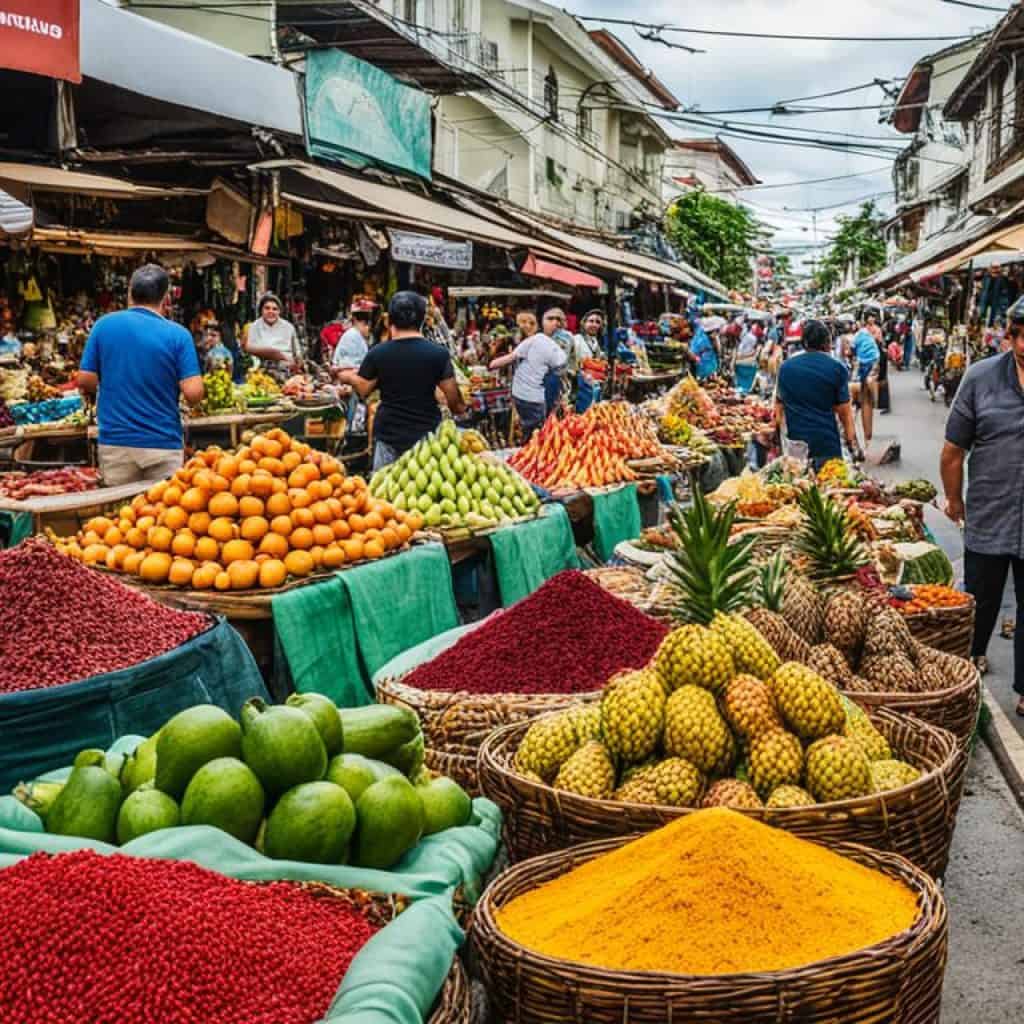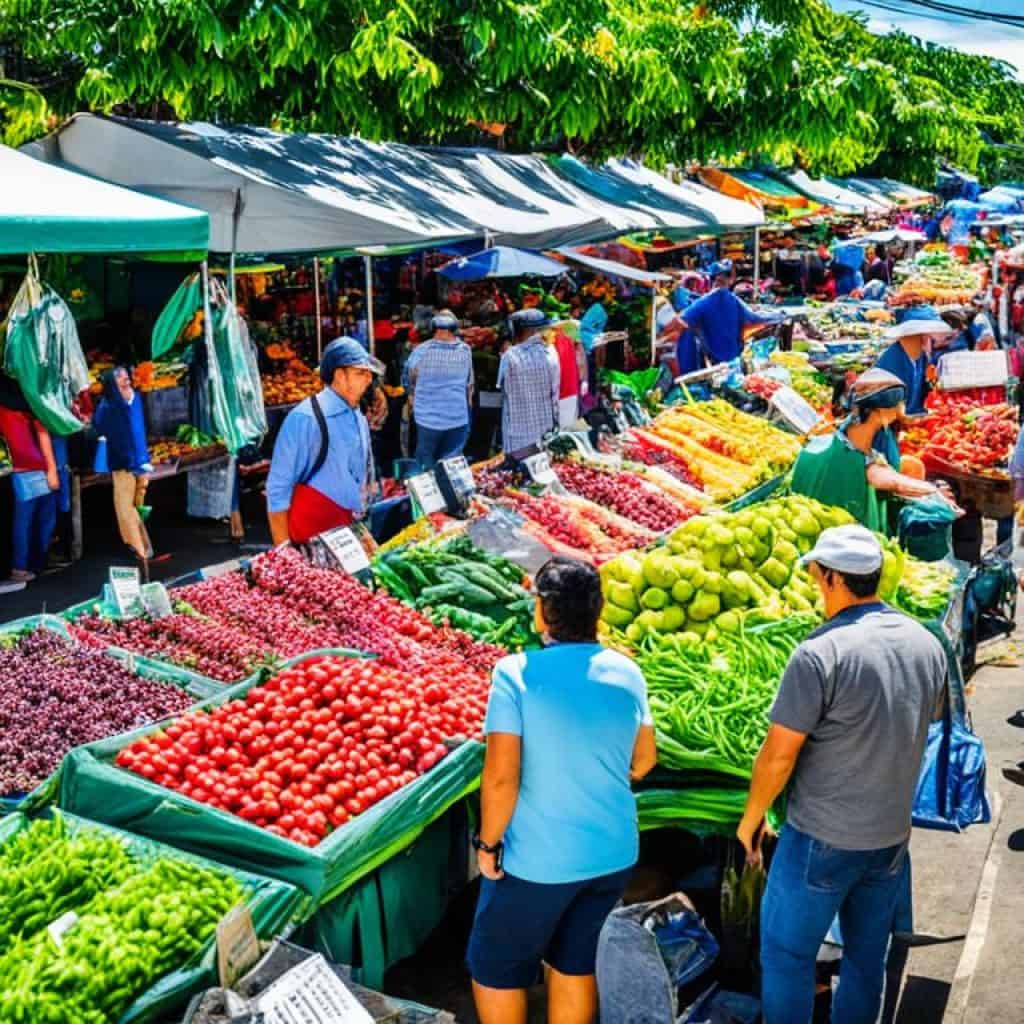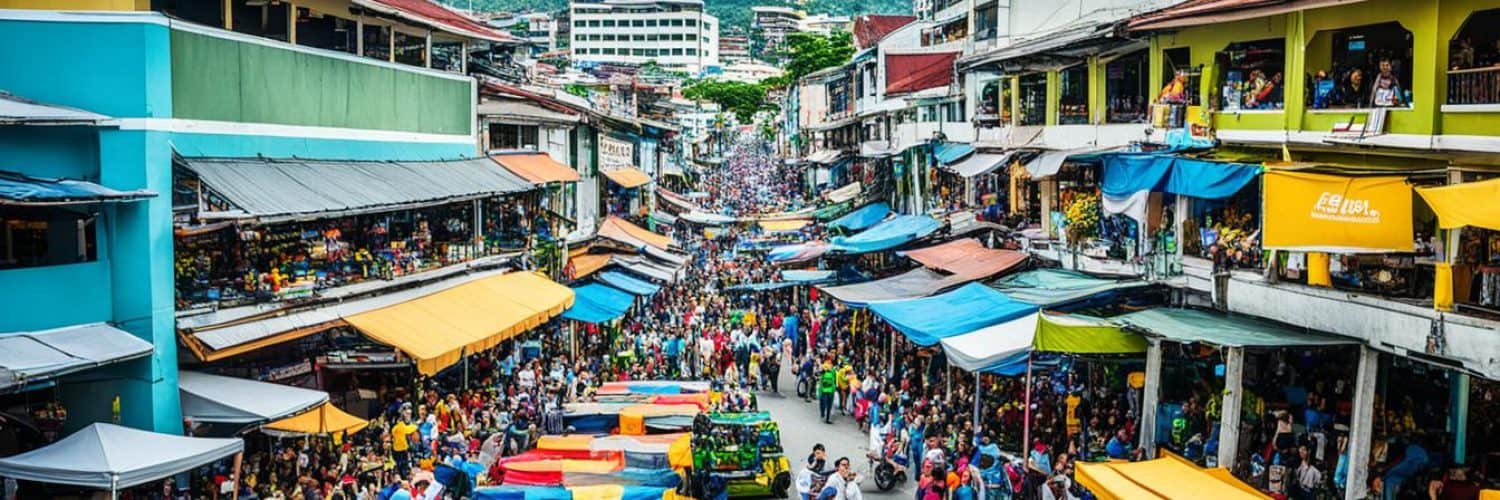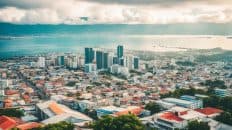Have you ever wondered why Cebu, a province in the central Visayas region of the Philippines, is considered a gem among travelers? What makes this island of Cebu so vibrant and enticing for adventurers from around the world? Let’s delve into the wonders of Cebu and uncover the secrets that make it a must-visit destination.
Key Takeaways:
- Cebu is strategically located in the central Visayas region of the Philippines, making it a convenient starting point for exploring the country.
- The region offers a seamless travel experience with its well-connected flight routes and an international airport.
- Cebu is home to stunning beaches, historical sites, and a vibrant cultural heritage, providing a diverse range of attractions for every traveler.
- Cebu serves as a gateway to the beautiful islands and destinations of the Philippines, making it the perfect base for island-hopping adventures.
- Exploring the vibrant region of Cebu allows visitors to immerse themselves in the authentic beauty and rich history of the Philippines.
Discovering Beautiful Beaches in Cebu
Cebu, located in the central Visayas region of Cebu Province, is blessed with an array of stunning beaches that captivate visitors with their pristine sands and sparkling turquoise waters. From luxurious resorts to secluded coastal spots, Cebu offers a diverse range of beach experiences.
One of the most popular beach destinations in Cebu is Mactan Island, known for its beautiful resorts and breathtaking beaches. Shangri-La’s Mactan Resort and Maribago Beach are among the top choices for travelers looking for a luxurious beach getaway.
In Moalboal, the white sandy beach is a must-visit. This beach is not only famous for its powdery sand but also its vibrant underwater life, making it perfect for snorkeling and diving enthusiasts.
Tingko Beach in Alcoy and Dalaguete Beach Park in Dalaguete offer a more laid-back atmosphere, where visitors can relax and soak up the sun. These beaches are ideal for swimming and picnicking, allowing you to unwind in a tranquil setting.
For those seeking a pristine and untouched beach experience, Lambug Public Beach in Badian is a hidden gem. With its long shoreline, clear waters, and peaceful surroundings, it offers a serene escape from the hustle and bustle of city life.
Whether you’re looking for a luxurious beach resort, an adrenaline-pumping water sports adventure, or a peaceful spot to unwind and reconnect with nature, Cebu’s beaches have something for everyone. Explore the beauty of these coastal wonders and create unforgettable memories in the region of Cebu.
Exploring Cultural and Historical Sites in Cebu
Cebu, a province in the central region of Cebu in the Philippines, is not only renowned for its breathtaking beaches but also for its rich cultural and historical heritage. This region offers visitors a chance to delve into the island’s history and spirituality through its iconic sites and landmarks.
Magellan’s Cross
Magellan’s Cross is a significant historical marker located in Cebu City. It symbolizes the arrival of Christianity in the Philippines. This cross, encased in a wooden structure, is said to be planted by Ferdinand Magellan during his expedition in 1521.
Basilica Minore del Santo Niño
The Basilica Minore del Santo Niño, located in Cebu City, is one of the oldest Roman Catholic churches in the country. It houses the image of the Santo Niño, a revered religious artifact that dates back to Magellan’s arrival. The basilica is a popular pilgrimage site for locals and tourists.
Tops Lookout
For panoramic views of Cebu City and its surrounding landscapes, a visit to Tops Lookout is a must. Located in the cool hills of Busay, Tops Lookout offers breathtaking vistas of the cityscape and the shimmering lights at night.
Osmena Peak Hike
Nature enthusiasts can embark on a hike to Osmena Peak, the highest point in Cebu. It offers majestic views of Cebu’s rolling hills and the neighboring islands. The hike is relatively easy, making it accessible for both novice and experienced hikers.
Simala Shrine
The Simala Shrine, situated in Sibonga, is a remarkable pilgrimage site known for its exquisite architecture. Devotees flock to the shrine to offer prayers and seek blessings from the miraculous image of the Virgin Mary.
Fort San Pedro
Fort San Pedro, located in Cebu City, is the oldest fort in the Philippines. Built by the Spanish in the 16th century, it served as a stronghold during colonial times. Today, visitors can explore its well-preserved structures and learn about its historical significance.
Taoist Temple
In the heart of Beverly Hills, Cebu City, stands the Taoist Temple, a significant cultural landmark. It is a celebrated venue for practicing Taoism, and visitors can embrace the serene ambiance, admire the intricate architecture, and participate in meditation sessions.
Cebu Metropolitan Cathedral
The Cebu Metropolitan Cathedral, situated in Cebu City, is a stunning architectural marvel. It serves as the ecclesiastical seat of the Metropolitan Archdiocese of Cebu. Visitors can appreciate its grandeur and attend religious ceremonies.
Experience the rich culture and history of Cebu through its cultural and historical sites. From the iconic Magellan’s Cross and Basilica Minore del Santo Niño to the breathtaking views of Tops Lookout and Osmena Peak, Cebu offers a variety of attractions that cater to different interests. Immerse yourself in the spiritual ambiance of the Simala Shrine and explore the historical significance of Fort San Pedro. Don’t forget to visit the Taoist Temple and marvel at the architectural beauty of the Cebu Metropolitan Cathedral. Discover the vibrant heritage of Cebu and create lasting memories during your visit.
Thrilling Water Activities in Cebu
When it comes to water activities, the region of Cebu in the central Visayas of the Philippines offers an abundance of thrilling experiences. Whether you’re seeking adventure or relaxation, Cebu has something to offer everyone.
- Moalboal Sardine Run: Witness the mesmerizing spectacle of the Moalboal Sardine Run, where countless sardines move in unison, creating a breathtaking display of nature’s beauty.
- Kawasan Falls Canyoneering: For adrenaline junkies, canyoneering at Kawasan Falls is a must. Jump, slide, and swim through the cascading waterfalls and turquoise pools for an exhilarating adventure.
- Oslob Whale Shark Watching: Immerse yourself in an awe-inspiring encounter with gentle whale sharks in Oslob. Get up close and personal with these magnificent creatures in their natural habitat.
- Island-Hopping Excursions: Explore the nearby islands of Hilutungan and Nalusuan through island-hopping excursions. Discover pristine beaches, vibrant marine life, and enjoy a day of sun and relaxation.
- Parasailing and Water Sports: For those who seek excitement, Mactan Island offers a variety of water sports activities, including parasailing, jet skiing, and banana boat rides.
- Scuba Diving in Malapascua: Dive into the enchanting depths of Malapascua Island, known for its exceptional scuba diving experiences. Explore vibrant coral reefs, encounter thresher sharks, and discover a world teeming with marine life.
With its diverse range of water activities, Cebu promises an unforgettable adventure for water enthusiasts and nature lovers alike. Whether you’re a thrill-seeker or seeking a tranquil escape, the region of Cebu has something to offer for everyone.
Immersing in Authentic Filipino Street Markets in Cebu
When exploring the vibrant region of Cebu in the Philippines, don’t miss the opportunity to experience the bustling street markets that offer an authentic glimpse into Filipino daily life. These vibrant markets showcase the rich culture, vibrant atmosphere, and delicious local flavors of the region. From fresh produce to local handicrafts, each street market in Cebu has its own unique charm.
Carbon Public Market
One of the must-visit street markets in Cebu is Carbon Public Market. Located in Cebu City, this market offers a lively ambiance with a wide array of fresh produce, local crafts, and even bargain clothes. You can find a variety of fruits, vegetables, spices, and condiments to sample the flavors of Cebu. The market teems with local vendors, creating a vibrant and bustling atmosphere that immerses you in the local culture and daily life of Cebuanos.
SM Seaside City Cebu
For a modern shopping experience in Cebu, head to SM Seaside City Cebu. This large shopping mall offers a wide range of local and international brands, providing you with the perfect opportunity to shop for souvenirs or indulge in a bit of retail therapy. Enjoy exploring the various shops and discover the latest fashion trends or find unique Cebu-made products.
Tabo-an Public Market
If you’re a seafood lover, Tabo-an Public Market is a must-visit destination. Renowned for its dried fish market, you’ll find an impressive variety of dried fish, including the popular danggit. Take in the aroma of the dried seafood, and witness the skillful display of different sizes and shapes. Tabo-an Public Market is also a great place to find Cebuano chorizo and other meat packed in colons for barbecuing. Don’t miss the chance to bring home some unique flavors of Cebu.
Lapu-Lapu Public Market
Located in Lapu-Lapu City, the Lapu-Lapu Public Market offers a wide selection of fresh seafood and local produce. Experience the vibrant seafood culture of Cebu by exploring the market’s stalls filled with fresh fish, crabs, prawns, and other local delicacies. It’s the perfect place to buy ingredients for a delicious seafood feast or witness the hustle and bustle of locals going about their daily lives.
Mango Square Mall
For a lively shopping, dining, and entertainment experience, head to Mango Square Mall in Cebu City. This popular hub is a go-to place for locals and visitors alike, offering a wide range of shops, restaurants, bars, and clubs. Shop for trendy clothes, enjoy a delicious meal, or dance the night away at one of its vibrant nightclubs. Mango Square Mall is a one-stop destination for shopping, dining, and nightlife in Cebu.
Exploring the street markets of Cebu provides a unique opportunity to immerse yourself in local culture and discover the authentic flavors of Filipino life. Whether you’re looking for fresh produce, local delicacies, or unique souvenirs, Cebu’s street markets offer a vibrant and unforgettable experience.

Experiencing the Authentic Philippines in Cebu City
While Cebu is famous for its stunning beaches and tourist spots, the city of Cebu offers a unique opportunity to experience the authentic Philippines beyond its natural attractions. It is important, however, to be mindful of the poverty and pollution issues that exist in the country. By being a responsible tourist and adopting sustainable practices during your trip, you can contribute to the betterment of the local community and environment.
As you explore the streets of Cebu City, you will undoubtedly witness the realities of Filipino daily life. From bustling markets and street vendors to the vibrant colors and sounds of the city, each corner of Cebu City offers a glimpse into the cultural diversity and rich heritage of the Philippines.
By engaging with the locals, you can gain a deeper understanding of their customs, traditions, and way of life. Don’t hesitate to strike up a conversation, try local delicacies, or participate in community activities. This direct interaction allows for a genuine connection with the people and offers a more meaningful travel experience.
“The beauty of Cebu City lies in its authenticity. Embracing the local culture and customs is the key to truly experiencing the Philippines.”
While it is necessary to be aware of the poverty that exists, it is equally important to recognize the resilience and warmth of the Filipino people. Engaging in responsible tourism practices and supporting local initiatives can empower the community and contribute to sustainable development.
Additionally, be mindful of the environmental impact of your visit. The Philippines faces significant challenges related to pollution, particularly in urban areas. By reducing waste, conserving resources, and practicing eco-friendly habits, you can help preserve the natural beauty of the region for future generations to enjoy.
Remember, a trip to Cebu City offers more than just beautiful sights. It provides an opportunity to immerse yourself in the authentic Philippines, connect with the local community, and gain a deeper understanding of this remarkable country.
Responsible Tourism Tips
| Responsible Tourism Tips | Description |
|---|---|
| Support Local Businesses | Choose locally owned accommodations, restaurants, and tour operators to support the local economy. |
| Respect Local Customs and Traditions | Learn about and adhere to local customs, traditions, and etiquette to show respect to the community. |
| Reduce Waste | Carry a reusable water bottle, say no to single-use plastics, and dispose of waste responsibly. |
| Engage in Community-based Tourism | Participate in community activities, homestays, or volunteering opportunities to support local communities directly. |
| Conserve Resources | Practice water and energy conservation, and be mindful of your actions’ environmental impact. |
| Learn About the Local Culture | Take the time to study and appreciate the local culture, traditions, and history before and during your visit. |
The Oldest Street in Cebu – Colon Street
Colon Street, the oldest street in the Philippines, holds a significant place in Cebu City’s history. As you stroll along this historic street, you will step back in time and witness the stories of Cebu’s past. Originally named after Christopher Columbus, Colon Street was once the center of business and social events, bustling with activity and serving as a key hub for trade.
Throughout its long history, Colon Street has witnessed the rise and fall of the economy, and has adapted to the changing times. As Cebu City has grown and evolved, Colon Street has remained a constant, a living testament to the city’s heritage.
While Colon Street may not boast the same aesthetic appeal as other parts of the city, its authenticity and vibrancy make it an essential stop on any visit to Cebu. The street is lined with shops, vendors, and eateries, offering a glimpse into the daily life of Cebu City. Immerse yourself in the hustle and bustle of the street as you explore the various shops and stalls, where you can find anything from local delicacies to traditional handicrafts.
Visitors should be aware of their surroundings and keep a close eye on their belongings, as Colon Street can be a target for pickpockets. However, with the right precautions, it is a fascinating and rewarding experience that allows you to uncover the rich history and culture of Cebu City.
Notable landmarks on Colon Street:
- Museo Sugbo: Explore the history and heritage of Cebu at this former provincial jail turned museum.
- Cebu Metropolitan Cathedral: Visit the mother church of the Cebu Archdiocese and admire its beautiful architecture.
- University of the Visayas: Discover one of the oldest educational institutions in Cebu, founded in 1919.
- Heritage of Cebu Monument: Marvel at this massive sculpture that depicts significant events in Cebu’s history.
Colon Street is more than just a road; it is a window into Cebu City’s storied past. Take a leisurely stroll along this historic street and immerse yourself in the rich culture and heritage of the region.
Taboan Market – A Danggit Lover’s Paradise
Located in the region of Cebu, Taboan Market is a must-visit destination for food lovers in the Cebu province. This lively market is renowned for its wide variety of dried fish, particularly the popular danggit. Step into Taboan Market and immerse yourself in a sensory paradise.
As you navigate through the market, you’ll be greeted by skillfully displayed dried fish in various sizes and shapes. The aroma of smoked and sun-dried fish fills the air, creating an enticing atmosphere. It’s a feast for the senses, with rows upon rows of dried fish hanging from racks, tempting visitors with their rich flavors.
Taboan Market is not only famous for danggit but also offers a wide selection of other dried fish varieties, such as pusit (squid) and tuyo (anchovies). These dried fish are a staple in Filipino cuisine, known for their distinct flavors and versatility in various dishes.
In addition to dried fish, Taboan Market is a great place to find Cebuano chorizo, a local sausage made from ground pork, spices, and vinegar. These flavorful sausages are perfect for grilling and are a delicious addition to any barbecue feast.
Indulge in Local Delicacies
Visiting Taboan Market provides more than just a shopping experience; it offers an opportunity to connect with friendly Filipinos and immerse yourself in the local culture. Engage in conversations with the vendors, who are always willing to share their stories and recommend the best products.
“Taboan Market is a haven for food enthusiasts. The vibrant atmosphere, the diverse array of dried fish, and the enticing aroma make it a unique and memorable experience. Plus, you can’t leave without trying some Cebuano chorizo!” – Local Food Enthusiast
Taboan Market is a place where locals and tourists alike come together to celebrate the rich flavors and culinary traditions of Cebu. Whether you’re a food lover searching for unique ingredients or a curious traveler seeking an authentic local experience, Taboan Market is the perfect destination.
| Dried Fish Varieties | Description |
|---|---|
| Danggit | A popular dried fish variety with a distinct sweet and savory flavor. Perfect for breakfast or as a snack. |
| Pusit | Sun-dried squid with a chewy texture and rich umami taste. Pairs well with vinegar dipping sauce. |
| Tuyo | Small dried anchovies packed with intense flavors, commonly used in Filipino dishes like pinakbet and sinigang. |
Don’t miss the opportunity to visit Taboan Market and explore the incredible variety of dried fish and Cebuano chorizo. It’s a food lover’s paradise that offers a taste of local experience in the vibrant region of Cebu.
Carbon Market – The Biggest Farmer’s Market in Cebu
Welcome to Carbon Market, the largest and oldest farmer’s market in Cebu. Located in the heart of Cebu City, this bustling market offers a truly authentic experience for both locals and visitors alike.
At Carbon Market, you’ll find a wide variety of fresh, locally sourced produce. From vibrant fruits and vegetables to a diverse selection of fish, seafood, and poultry, this market showcases the bountiful agricultural offerings of the region. As you navigate through the market, you’ll be greeted by the sights and smells of local farmers proudly displaying their crops.
One of the highlights of Carbon Market is the opportunity to engage with local artisans and craftsmen. You’ll discover beautifully handcrafted items such as baskets and straw bags, which make for unique souvenirs and gifts to bring back home.
Carbon Market not only provides a rich selection of local produce and handicrafts, but it also offers an insight into the daily lives of the Cebuano people. As you wander through the market, you’ll witness the vibrant energy and vibrant culture that permeates this thriving hub of commerce.

Come and experience the vibrant atmosphere of Carbon Market, where the community gathers to connect, trade, and celebrate the rich agricultural heritage of the region. Whether you’re looking for fresh ingredients for a home-cooked meal or simply want to immerse yourself in the local culture, a visit to Carbon Market is a must for an authentic Cebuano experience.
Experiencing Authentic Filipino Culture in Cebu
Cebu City offers a unique opportunity to immerse yourself in the vibrant and authentic culture of the Philippines. Beyond the stunning beaches and tourist spots, Cebu provides a glimpse into the everyday lives of the Filipino people and the traditions that shape their identity. It is a chance to connect with the heart and soul of the country, gaining a deeper understanding of its rich heritage and fascinating history.
Witnessing the Realities
Exploring the streets of Cebu City allows you to witness the realities of Filipino daily life. From the bustling markets to the crowded neighborhoods, you’ll encounter the warm smiles and resilient spirits of the locals. It is here that you can truly appreciate the strong sense of community and the genuine hospitality that the Filipino people are known for.
However, it is important to be mindful of the challenges that many Filipinos face, including poverty and pollution. The Philippines has a high poverty rate, and it’s essential to approach your visit with empathy and respect. By supporting responsible tourism practices and being conscious of your impact on the environment, you can make a positive difference in the lives of the locals and contribute to sustainable development.
Embracing Responsible Tourism
Being a responsible traveler means being aware of how your actions can affect the local community and the environment. When visiting Cebu, consider supporting local businesses and artisans, such as purchasing handmade crafts and souvenirs from street markets like Carbon Market. By doing so, you directly contribute to the economic growth of the region and empower local entrepreneurs.
To minimize your environmental impact, adopt eco-friendly practices during your stay. Reduce plastic waste by bringing a reusable water bottle and saying no to single-use plastics. Respect the natural beauty of Cebu by not littering and following responsible hiking and beach etiquettes.
Enriching Cultural Experiences
Explore Cebu’s cultural heritage by visiting historical sites like Magellan’s Cross and Fort San Pedro. These landmarks carry deep historical significance and provide a glimpse into the colonial past of the country. Pay a visit to the Basilica Minore del Santo Niño, where you can witness the devotion and religious festivities that play a central role in Filipino culture.
You can also indulge in the local cuisine at traditional eateries, savoring iconic dishes like lechon (roast pig) and kinilaw (ceviche). Engage with the locals, listen to their stories, and learn about their customs and traditions. By embracing these cultural experiences, you’ll forge a lasting connection with the people of Cebu and gain a profound appreciation for the Filipino way of life.
Image
The Oldest Street in Cebu – Colon Street
Colon Street, the oldest street in the Philippines, holds a significant place in Cebu City’s history. It was once the center of business and social events and witnessed the rise and fall of the economy over the years.
With its rich history and cultural significance, Colon Street offers a unique glimpse into the vibrant past of Cebu City. Despite its modest appearance, the street is bustling with shops, vendors, and a lively atmosphere that reflects the real-life of the bustling city.
Visitors strolling along Colon Street can immerse themselves in the vibrant energy of Cebu City, exploring the diverse range of shops and establishments that line the sidewalk. From local boutiques and specialty stores to street food vendors and traditional market stalls, there is always something interesting to discover.
Colon Street is not only a testament to Cebu City’s history but also a reflection of its present. As the oldest street in the Philippines, it captures the essence of the region’s rich heritage, making it a must-visit destination for history enthusiasts and curious travelers alike.
However, it’s important to note that Colon Street can also be a target for pickpockets, so visitors should exercise caution and keep their belongings secure.
Exploring Colon Street is a unique experience that allows visitors to connect with the city’s past, witness its vibrant present, and immerse themselves in the rich local culture.
Taboan Market – A Danggit Lover’s Paradise
Taboan Market in Cebu Province is a must-visit destination for food lovers. This bustling market is famous for its wide variety of dried fish, particularly the beloved danggit. As you wander through the market, you’ll be greeted by rows and rows of skillfully displayed dried fish in various sizes and shapes, creating a colorful and aromatic feast for the senses.
But Taboan Market has more to offer than just dried fish. It’s also the perfect place to find Cebuano chorizo, a flavorful local sausage. You can also discover other meats packed in colons for barbecuing, adding a unique touch to your culinary adventures.
Visiting Taboan Market is not only about indulging in delicious delicacies but also about immersing yourself in the local culture. As you interact with the friendly Filipinos and witness their vibrant trade, you’ll get a genuine taste of the local experience.
Experience the Best of Cebu’s Culinary Delights
At Taboan Market, you can savor the flavors of Cebu Province and take home authentic local ingredients to elevate your own cooking. Whether you’re a fan of dried fish, Cebuano chorizo, or simply curious about the bustling market atmosphere, Taboan Market is the place to be.
“Taboan Market offers a unique opportunity to discover the vibrant flavors of Cebu and engage with the local community. From dried fish to Cebuano chorizo, this market is a paradise for food enthusiasts looking for an authentic culinary experience.”
So, make sure to include Taboan Market on your itinerary and embark on a mouthwatering journey through the flavors of Cebu Province.
Carbon Market – The Biggest Farmer’s Market in Cebu
When it comes to experiencing the authentic flavors of Cebu, there’s no better place than Carbon Market, the largest and oldest farmer’s market in the region of Cebu. With its vibrant atmosphere and diverse array of products, this bustling market offers a true taste of local culture and a glimpse into the daily lives of the people.
At Carbon Market, you’ll find an abundance of fresh fruits and vegetables, sourced directly from local farmers. From plump mangoes and juicy watermelons to crisp lettuce and vibrant peppers, the market showcases the rich agricultural heritage of Cebu Province. It’s a feast for the senses, with colorful produce arranged in neat rows, inviting visitors to explore and indulge in the bounty of the land.
Seafood lovers will also be delighted by the selection at Carbon Market. From succulent shrimps and sweet crabs to a variety of fish, the market offers a wide range of options for those seeking the freshest catch. Whether you’re in the mood for a simple grilled fish or planning a sumptuous seafood feast, Carbon Market has you covered.
But Carbon Market isn’t just about fruits and seafood. The market is also a treasure trove for handcrafted items, perfect for those looking for unique souvenirs. Local artisans display their skill and creativity through beautifully woven baskets, intricate straw bags, and other traditional crafts. These handmade pieces are not only a testament to the talent of the craftsmen but also serve as a reminder of the vibrant culture and heritage of the region.
Visiting Carbon Market isn’t just about shopping for local produce; it’s an authentic experience that immerses you in the everyday life of the locals. Engage in friendly conversations with the vendors, learn about their farming techniques, and savor the local flavors that define Cebu Province.
If you want to truly experience the essence of Cebu, a trip to Carbon Market is a must. Lose yourself in the lively atmosphere, discover the abundance of local produce, and take home a piece of Cebu’s rich heritage.
Cebu Carbon Market Operating Hours:
| Day | Time |
|---|---|
| Monday | 6:00 AM – 6:00 PM |
| Tuesday | 6:00 AM – 6:00 PM |
| Wednesday | 6:00 AM – 6:00 PM |
| Thursday | 6:00 AM – 6:00 PM |
| Friday | 6:00 AM – 6:00 PM |
| Saturday | 6:00 AM – 6:00 PM |
| Sunday | Closed |
Embracing the Authentic Side of Cebu
Cebu City offers more than just stunning beaches, providing an opportunity to immerse yourself in the authentic side of the Philippines. While the region of Cebu is known for its natural beauty and vibrant tourist spots, it is crucial to be aware of the poverty and pollution issues faced by the country. By practicing responsible tourism and being mindful of your environmental impact, you can contribute positively to the local community and help preserve the pristine beauty of the region.
Exploring the streets of Cebu City allows you to witness the realities of Filipino daily life and gain a deeper understanding of the local culture. Stroll through the bustling markets, where locals sell their fresh produce and handcrafted items, and engage in friendly conversations with the people of Cebu. By embracing the authentic side of Cebu, you can have a truly meaningful and enriching experience that goes beyond the surface-level attractions.
“Traveling is not just about seeing the sights, it’s about connecting with the people and understanding their way of life. Embracing the authentic side of Cebu allows you to create lasting memories and forge meaningful connections with the local community.”
Responsible tourism also means being sensitive to the needs and challenges faced by the local population. Cebu struggles with poverty, and by supporting local businesses and social initiatives, you can contribute to the economic growth of the region. Additionally, by reducing waste and adopting sustainable practices during your trip, such as avoiding single-use plastics and properly disposing of trash, you can help combat pollution and preserve the natural beauty of Cebu’s landscapes.
Embracing the authentic side of Cebu is a chance to experience the true essence of the Philippines and gain a deeper appreciation for its rich cultural heritage. By being respectful, responsible, and open-minded, you can make a positive impact while creating unforgettable memories in the beautiful region of Cebu.
Conclusion
The region of Cebu in the central Visayas of the Philippines is a vibrant destination that offers a diverse range of experiences. From stunning beaches and historical sites to authentic street markets and cultural immersion, Cebu has something for every traveler. It is a gateway to explore the beauty of the Philippines and serves as a starting point for island-hopping adventures. By appreciating the natural beauty and embracing the authentic side of Cebu, visitors can have an unforgettable journey through this enchanting region.


















Add comment